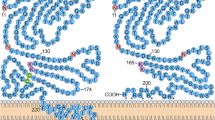Abstract
Background
Patients with solo tumour malignancy are at higher risk of developing venous thromboembolism. When prophylactic anticoagulation (and in particular heparin) is used during cancer therapy however, patients appear to have a prolonged survival. Tumours express large quantities of procoagulant molecules, which predispose patients to these conditions. Tissue Factor (TF) is an important example, which may have a role in the biology of malignant disease. Intra-tumour vessel coagulation however is not a common phenomenon. Our hypothesis is that cancer cells produce anticoagulant molecules, which may prevent intra-tumour vessel auto-coagulation. Our results show that one such factor—Tissue Factor Pathway Inhibitor (TFPI-1) is expressed by a number of different cancer cells.
Methods
Seven human cancer cell lines were studied: three breast, two colorectal and two pancreatic. Cells were maintained in cell culture, and at 90% confluence protein and RNA were extracted. RNA integrity was confirmed using an RNA integrity gel and RNA purity determined by spectrophotometry. Reverse transcription polymerase chain reaction (RT-PCR) was used for TFPI-1 mRNA detection and immunoblotting used for TFPI-1 protein detection.
Results
Six cell lines (two breast, two colorectal, and two pancreatic) expressed the TFPI-1 gene. Gene function was confirmed by detection of TFPI-1 protein expression in these cell lines.
Conclusion
TFPI-1 is expressed by breast cancer and other cancer cell lines maintained in cell culture. This has not been previously reported. Functional expression of TFPI-1 by cancer cells suggests that it has an important role in cancer biology. Further experiments are required to establish its function.



Similar content being viewed by others
References
Bajaj MS, Kuppuswamy MN, Saito H, Spitzer SG, Bajaj SP (1990) Cultured normal human hepatocytes do not synthesise lipoprotein-associated coagulation inhibitor: evidence that endothelium is the principal site of its synthesis. Proc Natl Acad Sci USA 87:8869–8873
Rana SV, Reimers HJ, Pathikonda MS, Bajaj SP (1988) Expression of tissue factor and factor VIIa/tissue factor inhibitor activity in endotoxin or phorbol ester stimulated U937 monocyte-like cells. Blood 71:259–262
Ameri A, Kuppuswamy MN, Basu S, Bajaj SP (1992) Expression of tissue factor pathway inhibitor by cultured endothelial cells in response to inflammatory mediators. Blood 79:3219–3226
Osterud B, Bajaj MS, Bajaj SP (1995) Sites of tissue factor pathway inhibitor and tissue factor expression under physiologic and pathological conditions. Thromb Haemost 73:873–875
Broze GJ Jr, Warren LA, Novotny WF, Higuchi DA, Girard JJ, Miletich JP (1988) The lipoprotein-associated coagulation inhibitor that inhibits factor VII-TF complex also inhibits factor Xa: insight into its possible mechanism of action. Blood 71:335–343
Wun TC, Kretzmer KK, Girard TJ, Miletich JP, Broze GJ Jr (1988) Cloning and characterisation of a cDNA coding for the lipoprotein-associated coagulation inhibitor shows that it consists of three tandem Kunitz-type inhibitory domains. J Biol Chem 263:6001–6004
Girard TJ, Warren LA, Novotny WF, Likert KM, Brown SG, Miletich JP, Broze GJ Jr (1989) Functional significance of Kunitz-type inhibitory domains of lipoprotein-associated coagulation inhibitor. Nature 338:518–520
Murray JC (1983) Coagulation and cancer. Br J Cancer 64:14–31
Rao LMV (1992) Tissue factor as a tumour procoagulant. Cancer Metastasis Rev 11:249–266
Gordon SG (1992) Cancer cell procoagulants and their role in malignant disease. Semin Thromb Haemost 18:424–433
Costantini V, Zacharaski LR (1993) Fibrin and cancer. Thromb Haemost 69:406–414
Kakkar AK, Chinswangwatanakul V, Lemoine NR, Tebbutt S, Williamson RC (1999) Role of tissue factor expression on tumour cell invasion and growth of experimental pancreatic adenocarcinoma. Br J Surg 86:890–894
Hoek K, Rimm DL, Williams KR, Zhao H, Ariyan S, Lin A, Kluger HM et al (2004) Expression profiling reveals novel pathways in the transformation of melanocytes to melanomas. Cancer Res 64(15):5270–5282
Kakkar AK, Hedges AR, Williamson RCN, Kakkar VV (1995) Perioperative heparin therapy inhibits late death from metastatic cancer. Int J Oncol 6:885–888
Kingston RD, Fielding JWL, Palmer MK (1993) Peri-operative heparin. A possible adjuvant to surgery in colorectal cancer? Int J Colorectal Dis 8:111–115
Kohanna FH, Sweeney J, Hussey S, Zacharski LR, Salzman EW (1983) Effect of peri-operative low-dose heparin administration on the course of colon cancer. Surgery 93:433–438
Lebeau B, Chastang C, Berchot JM (1994) Subcutaneous heparin treatment increases survival in small cell lung cancer. Cancer 74:38–45
Iochmann S, Reverdiau-Moalic P, Beaujean S, Rideau E, Lebranchu Y, Bardos P, Gruel Y (1999) Fast detection of tissue factor and tissue factor pathway inhibitor messenger RNA in endothelial cells and monocytes by sensitive reverse transcription polymerase chain reaction. Thromb Res 94:165–173
Kataoka H, Uchno H, Asada Y, Hatakeyama K, Nabeshima K, Sumiyoshi A, Koono M (1997) Analysis of TF and TFPI expression in human colorectal carcinoma cell lines and metastatic sublines to the liver. Int J Cancer 72:878–884
Kakkar AK, Chinswangwatanakul V, Tebbutt S, Lemoine NR, Williamson RC (1998) A characterisation of the coagulant and fibrinolytic profile of human pancreatic carcinoma cells. Haemostasis 28:1–6
Werling RW, Zacharski LR, Kisiel W, Bajaj SP, Memoli VA, Rousseau SM (1993) Distribution of tissue factor pathway inhibitor in normal and malignant human tissues. Thromb Haemost 69:366–369
Gyorffy B, Surowiak P, Kiesslich O, Denkert C, Schafer R, Dietel M, Lage H (2006) Gene expression profiling of 30 cancer cell lines predicts resistance towards 11 anticancer drugs at clinically achieved concentrations. Int J Cancer 118(7):1699–1712
Acknowledgements
The author would like to thank Mr. G. Nash, of the Thrombosis Research Institute, London, UK for providing the HUVEC cell line, and would like to thank Ms. Lisa Lowery, of the Department of Virology, Imperial School of Science, Technology and Medicine, Hammersmith Hospital, London, UK for providing the TFPI-1 primers.
Author information
Authors and Affiliations
Corresponding author
Additional information
Please note that the term “TFPI” refers to TFPI-1. The latter term did not exist before the purification of TFPI-2. Some authors are still using the term “TFPI” to refer to TFPI-1. To maintain the accuracy of the quoted references, both terms are used.
Rights and permissions
About this article
Cite this article
Kurer, M.A. Protein and mRNA expression of tissue factor pathway inhibitor-1 (TFPI-1) in breast, pancreatic and colorectal cancer cells. Mol Biol Rep 34, 221–224 (2007). https://doi.org/10.1007/s11033-006-9036-4
Received:
Accepted:
Published:
Issue Date:
DOI: https://doi.org/10.1007/s11033-006-9036-4




